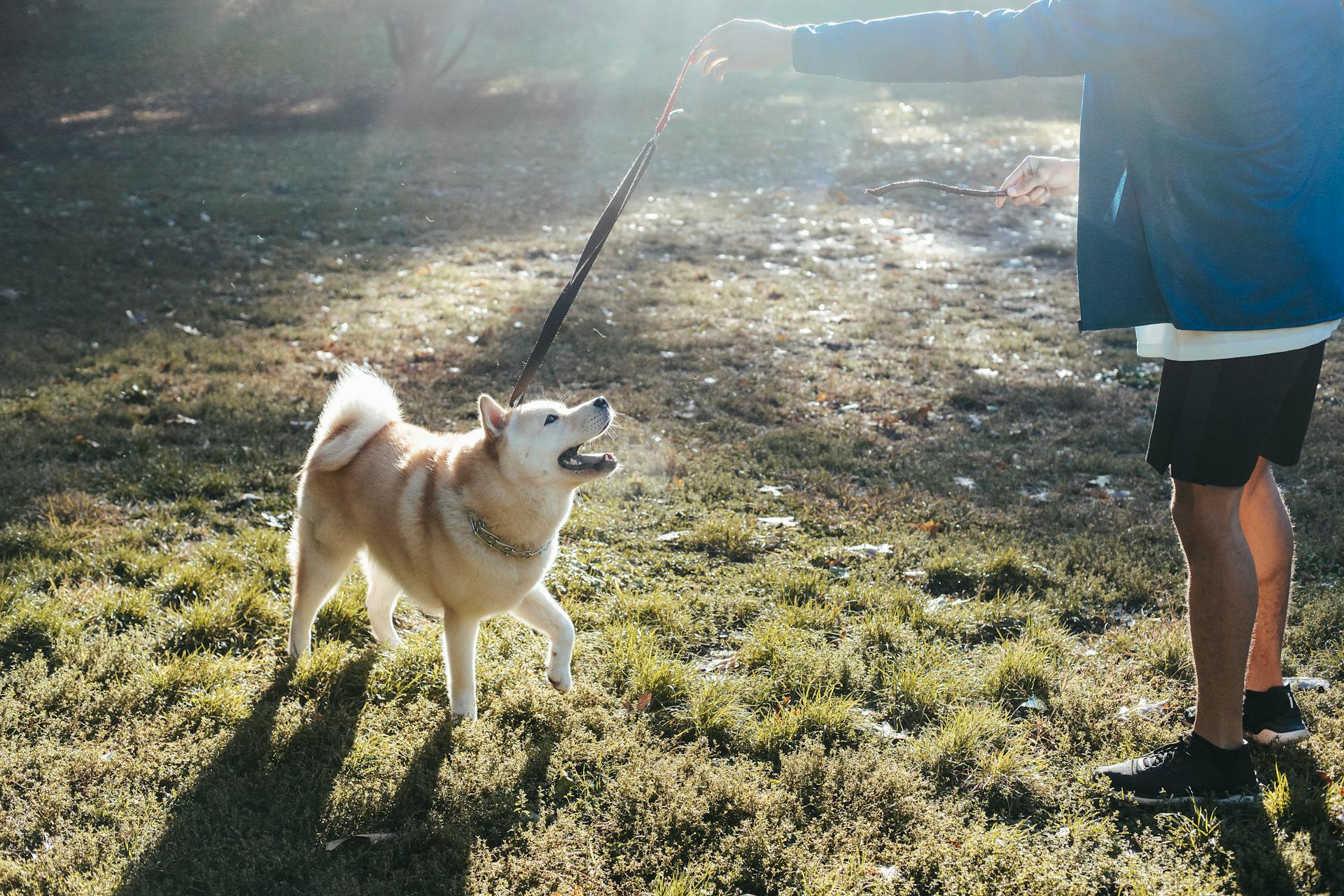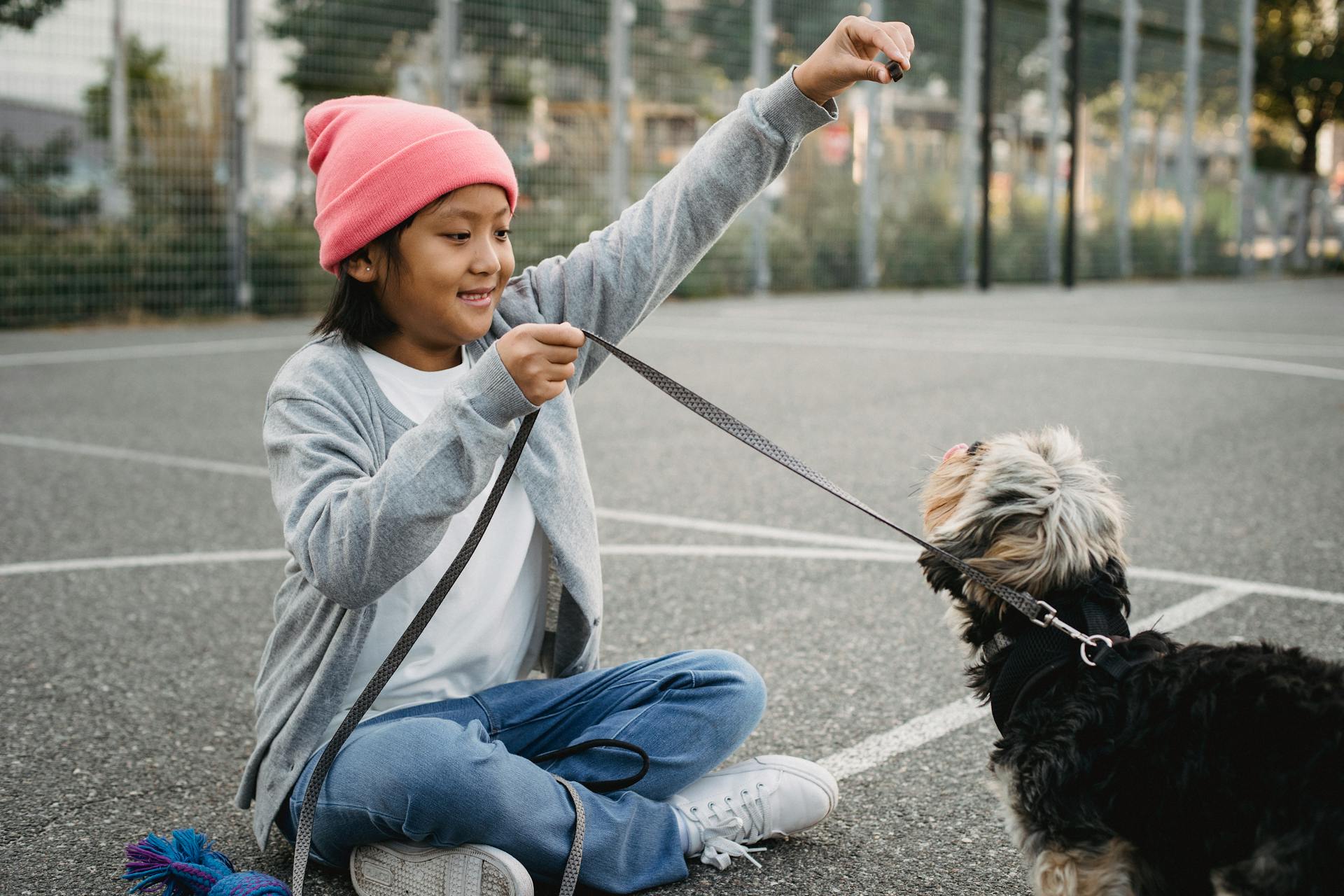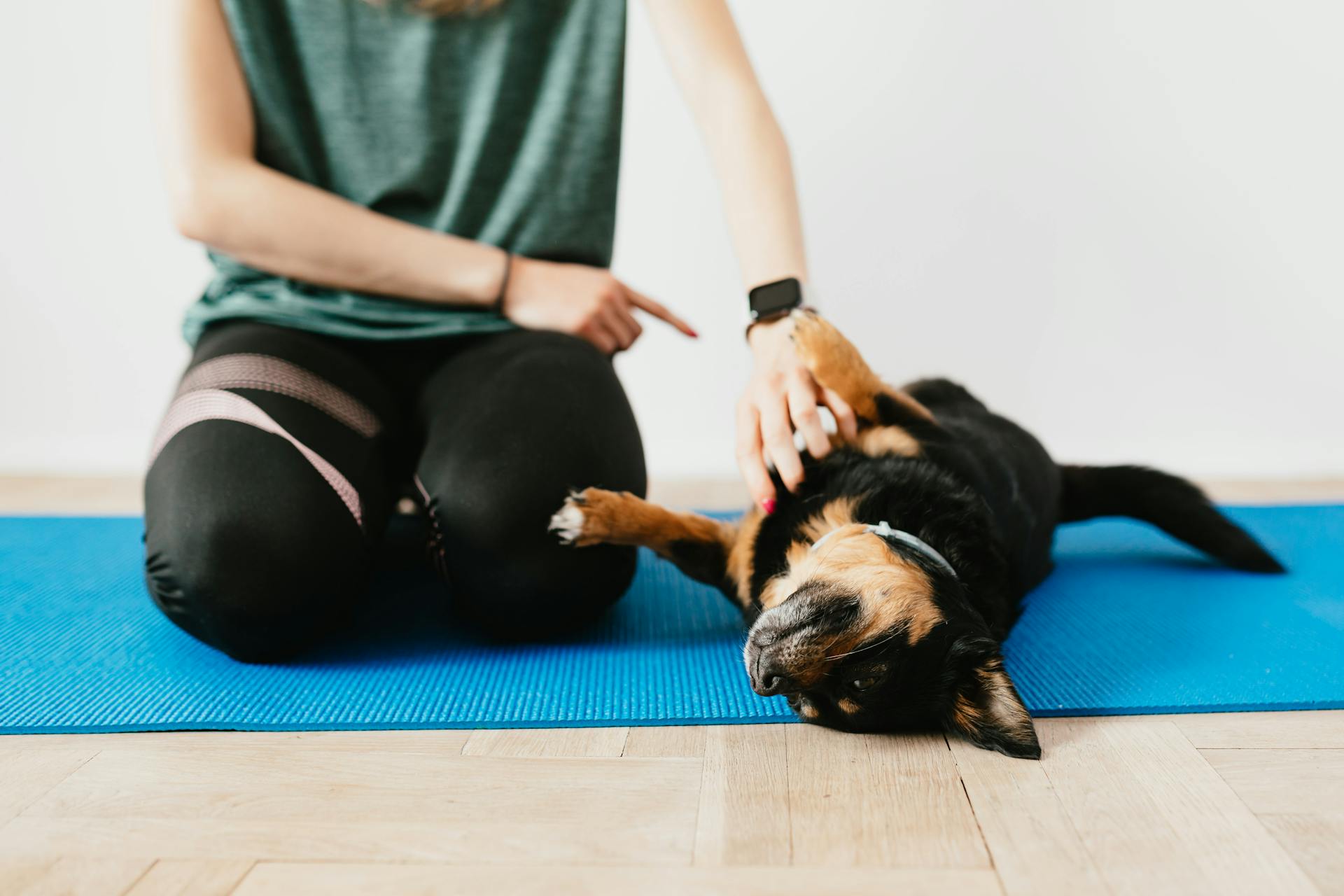
Training your dog at home can be a game-changer for their behavior and your relationship with them.
First, establish a routine and stick to it. Consistency is key when it comes to training a dog.
Dogs thrive on predictability and clear boundaries. Setting a schedule for feeding, exercise, and playtime helps them feel secure and in control.
Positive reinforcement is a powerful tool in dog training. Rewarding good behavior with treats, praise, and affection encourages your dog to repeat the desired action.
By using a combination of treats and praise, you can teach your dog to sit, stay, and come in no time.
Getting Started
Starting your dog's training at home is a great way to establish a strong bond and set them up for success. Knowing what to expect is key, and your pup needs to feel secure in their ability to meet the goals laid out going forward.
Positive reinforcement is the foundation of training, and it's a game-changer for getting your pup to listen. This means giving your dog a reward to encourage the behavior you want, like getting a paycheck for going to work.
Explore further: How to Discipline a Dog for Getting in the Trash
Avoid using punishment, as it can cause confusion and make your pup unsure about what's being asked of them. Punishment can be as simple as yelling or leash corrections, and it's not an effective way to train.
Reinforcement can be anything your dog likes, but most people use small pieces of a high-value food for training treats. Freeze-dried liver or even just kibble can be a great motivator.
Puppies can begin simple training as soon as they come home, usually around 8 weeks old.
Worth a look: Negative Punishment Dog Training
Basic Commands and Training
Training your dog at home can be a fun and rewarding experience for both you and your furry friend. Start by setting a basic foundation with a dog obedience program, which will help establish consistent protocols for you and your dog to follow.
To make training effective, use positive reinforcement techniques, such as rewarding good behavior with treats, toys, or praise. This approach encourages good behavior and ignores bad behavior, making it easier to train your dog.
Keep training sessions short and fun, lasting around 10 to 15 minutes, two to three times a day. This is especially true for puppies, who have short attention spans.
Some essential basic commands to teach your dog include "come", "sit", "stay", "lie down", and "back up." These commands will give your dog structure and help prevent common behavior problems.
To teach these basic commands, start with simple tasks like teaching your dog to sit and stay. You can use clicker training, a form of positive reinforcement, to make the process faster and more effective.
Here are the basic commands to get you started:
Remember, every dog is different, and what works for one may not work for another. Be patient and adjust your training methods as needed to ensure a fun and successful training experience for both you and your dog.
Housebreaking and Potty Training
Supervise your puppy at all times to prevent accidents indoors. This means keeping an eye on them whenever they're indoors, especially during the housebreaking process.
Tether your puppy to you or a nearby piece of furniture with a six-foot leash if you're not actively potty training or playing. Watch for signs that your puppy needs to go out, such as barking, scratching at the door, squatting, restlessness, sniffing around, or circling.
A regular schedule is key to successful housebreaking. Typically, a puppy can control their bladder one hour for every month of age, so if your puppy is 2 months old, they can hold it for about two hours.
Take your puppy outside frequently, at least every two hours, and immediately after they wake up, during and after playing, and after eating or drinking. Consistency is crucial in housebreaking.
Pick a bathroom spot outside and always take your puppy (on a leash) to that spot. Use a specific word or phrase to remind them what to do.
Reward your puppy every time they eliminate outdoors with praise or treats, but do so immediately after they've finished. This step is vital to teach what's expected of them.
A regular feeding schedule is also essential in housebreaking. Feed your puppy at the same times each day to make it more likely that they'll eliminate at consistent times.
If this caught your attention, see: Shock Collar for Puppy Biting
Confine your puppy to a small area when you're unable to supervise them, such as a bathroom or laundry room blocked off with baby gates. The space should be big enough to comfortably stand, lie down, and turn around.
If you're unable to supervise your puppy, confining them to a crate can be an effective solution. However, be sure to learn how to use a crate humanely as a method of confinement.
Here's a rough guide to help you plan your puppy's bathroom breaks:
Remember, consistency and patience are key to successful housebreaking. With time and effort, your puppy will learn to eliminate outdoors and become a well-behaved member of your family.
Leash and Walking
Leash training is a must for every dog, not just for obedience but for their own safety. You'll need to teach your dog to walk on a leash without pulling or lunging.
To introduce your dog to a leash, start by letting them get comfortable wearing it. Give them treats as you put the leash on each time. This will help them associate the leash with positive experiences.
When your puppy is comfortable wearing a leash, it's time to teach them to walk on it. Stand next to your puppy with the leash in a loose loop and give them treats for standing or sitting next to your leg. Take one step forward and encourage them to follow by giving another treat as they catch up.
As you walk forward, continue giving treats to your puppy at the level of your knee or hip. When they run in front of you, simply turn in the opposite direction, call them to you, and reward them in place.
Here are the steps to teach your puppy to walk on a leash:
- Introduce your puppy to a leash and make them comfortable wearing it.
- Stand next to your puppy with the leash in a loose loop and give them treats for standing or sitting next to your leg.
- Take one step forward and encourage them to follow by giving another treat as they catch up.
- Continue giving treats to your puppy at the level of your knee or hip as you walk forward.
- When they run in front of you, turn in the opposite direction and call them to you, then reward them in place.
Remember, loose leash walking is all about making the experience enjoyable for both you and your dog.
Socialization and Behavior
Socialization is a crucial part of dog training, and it's essential to start early. Socialization means exposing your puppy or adult dog to new people, animals, and places, which helps prevent behavior problems and fears.
Broaden your view: Dog Socialisation Training
Socialized dogs are generally happier and more well-behaved, making them more welcome in public. By socializing your dog, you can help prevent the development of fears and phobias.
To socialize your dog effectively, start with short sessions and gradually increase the duration and intensity. Keep things positive, and reward your dog for good behavior.
Here are some key facts to keep in mind:
- Socialization can start as early as 6 to 7 weeks old.
- Positive reinforcement is key to successful socialization.
- Interruption and redirection can help correct misbehavior.
How to Socialize
Socializing your dog or puppy is a crucial part of their development, and it's easier than you think.
To socialize your dog, start by exposing them to new people, animals, and places. This will help them become less likely to develop behavior problems and more welcomed by others.
You can socialize your dog by taking them to dog parks, puppy classes, or even just to your friends' houses. The more new experiences they have, the better they'll become at handling new situations.
Socialization can also help prevent the development of fears and phobias in your dog. This means that they'll be less likely to become anxious or scared in new situations, making them a happier and more well-behaved dog.
By socializing your dog, you'll be giving them the tools they need to become a confident and calm companion. And who doesn't want that?
A different take: Puppy Shock Collar
Behavior and Proofing
As you work on socialization and behavior with your dog, you'll inevitably encounter some bumps along the way. Problems and proofing behavior are a normal part of the training process.
Dog training takes time, and it's essential to keep things positive and rewarding. Use a reward system that your dog will work for, and avoid punishing them during training or becoming angry – this will only cause confusion.
A common mistake is to punish your dog during training or become angry, which will only cause confusion. Instead, try to hold your dog's attention with treats and enthusiasm.
To correct misbehavior, interrupt it and shift your dog's attention to something positive. Try running through cues that your dog has mastered followed by rewards.
The key to success is positive reinforcement. Successful training will be achieved with patience and consistency.
Here are some key facts to keep in mind:
- Dog obedience training is generally around $50 per session, but it might be higher depending on your geographical location and trainer.
- Obedience training teaches your dog about basic commands, behavior, socialization, and even how to handle basic grooming tasks.
- Proofing is the last step in training your dog to do any new behavior, and it's essential to practice behaviors in various places with different levels of distraction.
By understanding and addressing common behavior problems, you can detect and address them before things get out of control. Common behavior problems include jumping up, barking, or even aggression.
A different take: Cavachon Behavior Problems
Advanced Training
Advanced training is an ongoing process that will keep your dog active, fit, and mentally stimulated. It's essential to keep working on obedience training throughout your dog's life.
Remember, training is not a one-time event, but rather a continuous process. You'll never be completely finished, just like people who learn a language at a young age but stop speaking it may forget much of it as they grow older.
To keep your dog's training fresh in their mind, run through even the most basic tricks and commands regularly. This will help prevent them from forgetting what they've learned.
Short training sessions are best to ensure your dog doesn't feel overwhelmed, irritated, disinterested, or bored. Aim for several short sessions throughout the day, monitoring your dog's reactions to figure out when they've had enough.
Here are some tips for advanced training:
- Train your dog to ignore other dogs by keeping a distance and rewarding them with treats when they focus on you.
- Train your dog to stay with you by calling their name and rewarding them with treats when they come to you.
- Train your dog not to jump on people by having them sit and rewarding them with treats when they obey.
By following these tips, you can help your dog become a well-behaved and well-adjusted member of your family.
Training Equipment and Classes
If you're looking for structured training classes, Virtual Manners for Life is a 4-month program that covers the basics, including sit, down, stay, leash walking, and more. It's available virtually for $90.
The program also offers a discount for clients who complete the virtual Positively Puppies class, allowing you to continue learning with your pup.
Take a look at this: 6 Week Dog Training Program
Equipment
When choosing a dog collar or harness, make sure it's suitable and comfortable for your dog.
A retractable leash is not suitable for dog training, so choose a different type of leash that will help you and your dog learn together.
You'll also need dog training treats that your dog enjoys and are easy to eat quickly, so they can be a reward that's immediate and motivating.
Small pieces of plain cooked chicken or turkey make great homemade dog training treats that your dog will love.
Readers also liked: Will Neutering a Dog Stop Aggression
Group Classes
Group classes are a great way to stay motivated and learn new skills. Many gyms and fitness centers offer group classes that cater to different fitness levels and interests.
For your interest: Dog Training Group Classes

You can expect to burn around 400-600 calories per hour in a high-intensity interval training (HIIT) class, which is equivalent to a 30-minute run. This is because HIIT classes involve short bursts of intense exercise followed by brief periods of rest.
Group classes can be a fun and social way to exercise, allowing you to meet new people and make friends. Some gyms even offer classes that focus on specific areas of fitness, such as yoga or Pilates.
The cost of group classes can vary depending on the gym and location, but many gyms offer discounts for package deals or membership plans. For example, a 10-class package might cost around $100-$150.
Group classes are often led by experienced instructors who can provide guidance and support to help you get the most out of your workout. They can also help you modify exercises to suit your fitness level.
Take a look at this: Do Dog Diapers Help with Potty Training
Virtual Puppy and Adult Classes
Virtual puppy and adult classes are a great way to learn new skills from the comfort of your own home. These classes are perfect for those with hectic schedules or who prefer online learning.

Classes are structured around a 6-week format with 4-5 exercises each week, and you'll receive a video and written material for each exercise. You can move through the material at your own pace, on your own schedule, in the comfort of your own home.
If you're welcoming a new puppy into your home, Virtual Positively Puppies is a great resource. This class covers potty training, puppy play-biting, introducing the leash, early obedience skills, and socialization basics.
Virtual Manners for Life is another option for adult dogs, covering foundation skills like sit, down, stay, leash walking, and coming when called. Both classes cost $90 to enroll, and you'll have access to instructor support via phone, email, or video chat.
Expand your knowledge: Puppy Mill Dogs Behavior
Frequently Asked Questions
What are the 7 most important dog commands?
The 7 essential dog commands include "Stop", "Sit", "Down", "Heel", "Stay", "Leave it", and "Come", which form the foundation of a well-behaved and obedient pet. Mastering these basic commands is crucial for a happy and safe relationship between you and your dog.
Sources
- https://www.thesprucepets.com/steps-to-train-your-dog-1118273
- https://www.humanesociety.org/resources/how-potty-train-your-dog-or-puppy
- https://www.akc.org/expert-advice/training/teach-your-puppy-these-5-basic-commands/
- https://www.thesprucepets.com/start-dog-obedience-training-program-1118245
- https://www.kyhumane.org/services/dog-training/
Featured Images: pexels.com


